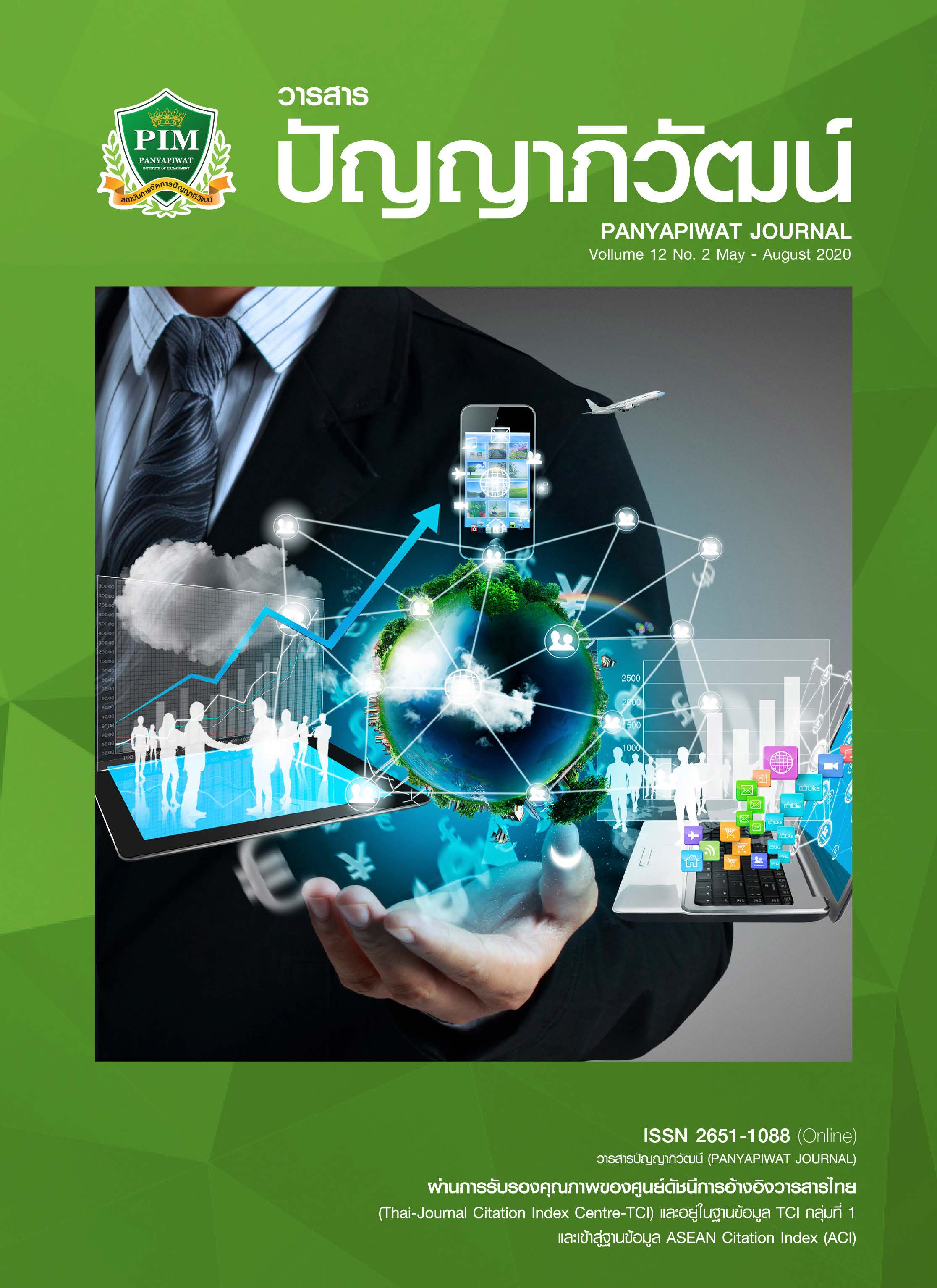ตัวแบบความตั้งใจใช้เอ็มคอมเมิร์ซแบบธุรกิจกับธุรกิจสำหรับผู้ประกอบการร้านค้าปลีกแบบดั้งเดิมในประเทศไทย
Main Article Content
บทคัดย่อ
M-Commerce หรือ Mobile Commerce เข้ามามีบทบาทในฐานะช่องทางการจัดจำหน่าย โดยเฉพาะการนำมาใช้เพื่อการค้าระหว่างธุรกิจกับธุรกิจหรือ B2B M-Commerce ในปัจจุบันบริษัทผู้ผลิตรายใหญ่ริเริ่มนำเข้ามาใช้ในการทำการค้าระหว่างบริษัทกับลูกค้ากลุ่มร้านค้าปลีกแบบดั้งเดิม แต่ยังไม่ประสบความสำเร็จเท่าที่ควร อาจเนื่องมาจากบริษัทยังไม่เข้าใจถึงพฤติกรรมการใช้เทคโนโลยีของผู้ประกอบการ อีกทั้งคุณลักษณะของผู้ประกอบการนั้นต่างกันไปตามประสบการณ์ ความคุ้นเคยกับเทคโนโลยี สภาพแวดล้อมของร้านค้า งานวิจัยนี้พัฒนาโดยใช้แบบจำลองการยอมรับเทคโนโลยีเป็นกรอบแนวคิดพื้นฐาน เพื่อศึกษาปัจจัยที่เกี่ยวข้องกับความตั้งใจใช้ B2B M-Commerce สำหรับผู้ประกอบการร้านค้าปลีกแบบดั้งเดิม โดยเพิ่มปัจจัยทางด้านความคุ้นเคยกับเทคโนโลยี อิทธิพลจากสภาพแวดล้อม และความไว้วางใจ ซึ่งเป็นปัจจัยที่ยังไม่ได้รับการศึกษาอย่างเพียงพอหรือไม่ได้มีการนำมาศึกษาร่วมกับแบบจำลองดังกล่าว เก็บข้อมูลจากกลุ่มตัวอย่างแบบเจาะจงผู้ตอบแบบสอบถามไปยังผู้มีอำนาจการตัดสินใจนำเทคโนโลยีไปใช้ในกิจการ จำนวน 506 คน ใช้การวิเคราะห์แบบจำลองสมการโครงสร้าง ในการวิเคราะห์ผลและทดสอบสมมติฐาน ผลการวิเคราะห์พบว่า ความคุ้นเคยกับเทคโนโลยี การรับรู้ถึงความง่ายในการใช้งาน การรับรู้ถึงประโยชน์ในการใช้งาน อิทธิพลจากสภาพแวดล้อม และความไว้วางใจใน B2B M-Commerce ส่งผลทางบวกต่อความตั้งใจใช้ B2B M-Commerce บริษัทที่ต้องการพัฒนาช่องทางจัดจำหน่ายด้วย B2B M-Commerce ควรให้ความสำคัญปัจจัยดังกล่าว จะช่วยให้เข้าใจถึงพฤติกรรมความตั้งใจใช้มากยิ่งขึ้น
Article Details
“ข้าพเจ้าและผู้เขียนร่วม (ถ้ามี) ขอรับรองว่า บทความที่เสนอมานี้ยังไม่เคยได้รับการตีพิมพ์และไม่ได้อยู่ระหว่างกระบวนการพิจารณาลงตีพิมพ์ในวารสารหรือแหล่งเผยแพร่อื่นใด ข้าพเจ้าและผู้เขียนร่วมยอมรับหลักเกณฑ์การพิจารณาต้นฉบับ ทั้งยินยอมให้กองบรรณาธิการมีสิทธิ์พิจารณาและตรวจแก้ต้นฉบับได้ตามที่เห็นสมควร พร้อมนี้ขอมอบลิขสิทธิ์บทความที่ได้รับการตีพิมพ์ให้แก่สถาบันการจัดการปัญญาภิวัฒน์หากมีการฟ้องร้องเรื่องการละเมิดลิขสิทธิ์เกี่ยวกับภาพ กราฟ ข้อความส่วนใดส่วนหนึ่งและ/หรือข้อคิดเห็นที่ปรากฏในบทความข้าพเจ้าและผู้เขียนร่วมยินยอมรับผิดชอบแต่เพียงฝ่ายเดียว”
เอกสารอ้างอิง
Anderson, J. C. & Gerbing, D. W. (1998). Structural equation modeling in practice: a review and recommended two-step approach. Psychological Bulletin, 3, 411.
Baier, A. (1986). Trust and Antitrust. The University of Chicago Press Journal, 96(2), 231-260.
Bhattacherjee, A. (2002). Individual Trust in Online Firms: Scale Development and Initial Test. Journal of Management Information Systems, 19(1), 211-241.
Boomsma, A. & Hoogland, J. J. (2001). The robustness of LISREL modeling revisited. In Cudeck, S., Toit, D. & Sörbom, D. (Eds.), Structural equation models: Present and future (pp. 139-168). Chicago: Scientific Software International Inc.
Brendan, W. (2016). 2016 Commerce Technology Investment Trends: Omnichannel. Retrieved August 10, 2017, from https://www.forrester.com/report/2016+Commerce+Technology +Investment+Trends+Omnichannel/-/E-RES116885
Carter, L. & Belanger, F. (2005). The Utilization of E-Government Services: Citizen Trust, Innovation and Acceptance Factors. Information Systems Journal, 15, 5-25.
Chanvarasuth, P. (2010). Adoption of E-business by Thai SMEs. International Journal of social, Behavior, Education, Economic, Business and Industrial Engineering, 4(5), 523-528.
Chen, Y. & Barnes, S. (2007). Initial trust and online buyer behavior. Industrial Management & Data Systems, 107(1), 21-36.
Chenhall, R. H. & Morris, D. (1986). The impact of structure, environment and interdependencies on the perceived usefulness of management accounting systems. Accounting Review, 61, 16-35.
Davis, F. D. (1985). A Technology Acceptance Model for Empirically Testing New End-User Information Systems: Theory and Results. Philosophiae Doctor, Massachusetts Institute of Technology, Sloan School of Management, Massachusetts Institute of Technology.
Davis, F. D. (1989). Perceived Usefulness, Perceived Ease of Use, and User Acceptance of Information Technology. MIS Quarterly, 13(3), 319-340.
Davis, F. D., Bagozzi, R. P. & Warshaw, P. R. (1989). User Acceptance of Compute Technology: A Comparison of Two Theoretical Models. Management Science, 35(8), 982-1003.
Gangwar, H., Date, H. & Ramaswamy, R. (2015). Developing a Cloud-Computing Adoption Framework. Global Business Review, 16(4), 632-651.
Gefen, D. (2000). E-Commerce: the role of familiarity and trust. OMEGA, 28(6), 725-737.
Gefen, D., Karahanna, E. & Straub, D. W. (2003). Trust and TAM in Online Shopping: An Integrated Model. MIS Quarterly, 27(1), 51-90.
Hair, J. F., Black, W. C., Babin, B. J., Anderson, R. E. & Tatham, R. L. (2014). Multivariate Data Analysis. (7th ed.). Chicago: Pearson Education, Inc.
Hussin, H. & Mohamad Noor, M. (2005). Innovating Business Through E-Commerce: Exploring The Willingness Of Malaysian Smes. In Welch, D. (Eds.). The Second International Conference On Innovations In It (Iit’05). Innovating Business Through E-Commerce: Exploring The Willingness Of Malaysian Smes (pp. 1-10). University Park, USA: Pennsylvania State University.
Ifinedo, P. (2011). An empirical analysis of factors influencing Internet/e-business technologies adoption by SMEs in Canada. International Journal of Information Technology & Decision Making, 10(4), 731-766.
Joo, S. & Choi, N. (2015). Factors affecting undergraduates’ selection of online library resources in academic tasks: Usefulness, ease-of-use, resource quality, and individual differences. Library Hi Tech, 33(2), 272-291.
Joreskog, K. G. & Sorbom, D. (2001). LISREL 8 User’s Reference Guide. Chicago: Scientific Software International.
Koufaris, M. & Hampton-Sosa, W. (2004). The development of initial trust in an online company by new customers. Information & Management, 41, 377-397.
Lankton, N. K., Mcknight, D. H. & Tripp, J. (2015). Technology, Humanness, and Trust: Rethinking Trust in Technology. Journal of the Association for Information Systems, 16(10), 880-918.
Marangunic, N. & Granic, A. (2015). Technology acceptance model: a literature review from 1986 to 2013. University Access Information Society, 14, 81-95.
McKnight, D. H., Carter, M., Thatcher, J. B. & Clay, P. F. (2011). Trust in a specific technology: an investigation of its components and measures. Transactions on Management Information Systems, 2(2), 1-15.
Ramdani, B., Kawalek, P. & Lorenzo, O. (2009). Predicting SMEs’ adoption of enterprise systems. Journal of Enterprise Information Management, 22(2), 10-24.
Thungwha, S. (2016). Consumer behavior and marketing mix (7ps) of traditional retailer. In Kotchasit, S. (Eds.). The 41st National and 5th International Graduate Research Conference 2016. Research Driven globalization. (pp. 143-156). Pathum Thani: Valaya Alongkorn Rajabhat University under the Royal Patronage. [in Thai]
Tornatzky, L. & Fleischer, M. (1990). The process of technology innovation. Lexington, MA: Lexington Books.
Venkatesh, V. & Davis, F. D. (2000). A Theoretical Extension of the Technology Acceptance Model: Four Longitudinal Field Studies. Management Science, 46(2), 186-204.
Yu, G. (2010). Effects of Presentation Mode and Computer Familiarity on Summarization of Extended Texts. Language Assessment Quarterly, 7, 119-136.
Zhao, L. & Chen, C. (2013). Understanding trust-related factors affecting citizen adoption of e-government services. Chinese Journal of Library and Information Science, 6(3), 31-92. [in Chinese]


